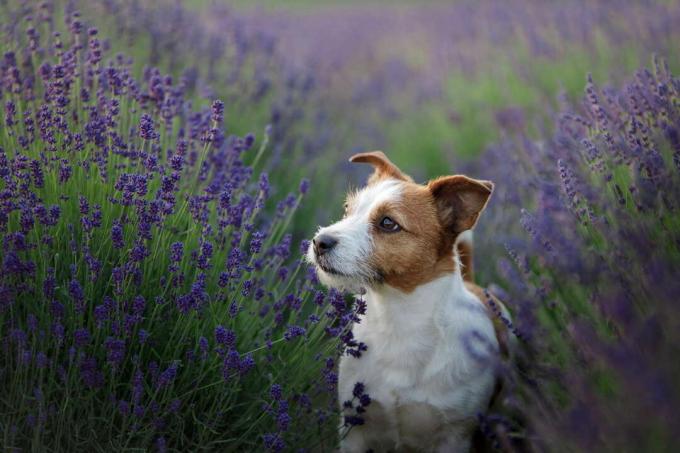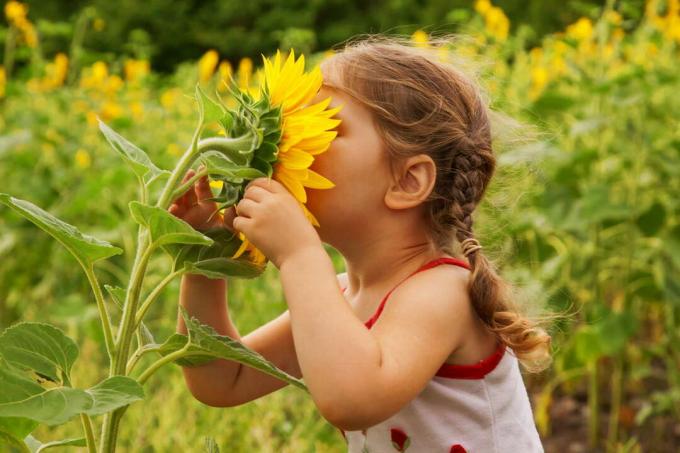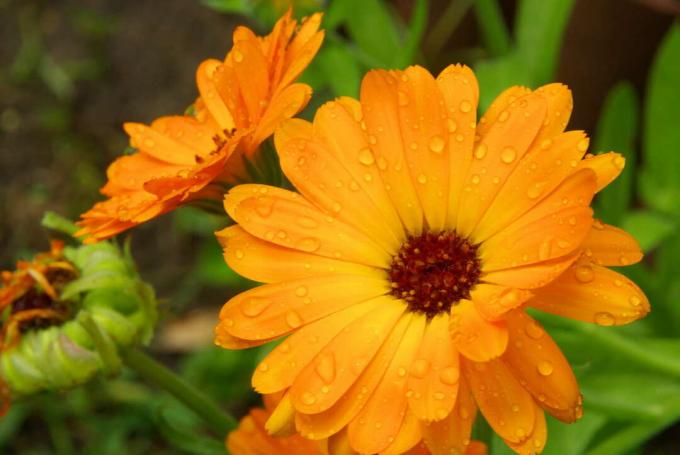Safe or toxic? We'll show you which ten plants are absolutely safe for children and pets too.

The garden is great for children and pets. Here you can run around undisturbed, play and spend a lot of time in the fresh air. But there is also a secret danger lurking in this place - if you don't pay attention for a moment, children put flowers in their mouths or pets nibble on the leaves.
contents
- 1. Tagetes
- 2. Corkscrew willow
- 3. lavender
- 4. Nasturtiums
- 5. Sunflower
- 6. Pansy
- 7. Linden tree
- 8. dahlia
- 9. Marigold
- 10. Crabapple
Is it now about Toxic plantsthere is no getting around the pediatrician or veterinarian. But also thorns and sharp leaves lead to painful cuts and injuries faster than expected. So that you can play outside with children and animals undisturbed, we reveal which ten plants are absolutely harmless and safe for children and pets.
1. Tagetes
As a colorful summer bloomer she found
Tagetes (Tagetes), also known as the marigold, entered German gardens around 400 years ago. It is still extremely popular today - especially its large, radiant flowers transform the marigolds into real eye-catchers. In addition, the beautiful flower is particularly robust and reliably repels pests such as certain nematode species (roundworms) and ants. However, the marigolds are absolutely harmless to children and pets - all varieties are non-toxic. On the other hand, only a few varieties are edible, such as the Spiced Tagetes (Tagetes tenuifolia), because even if the marigold is absolutely non-toxic, most varieties taste unpleasantly bitter, so that they are often spit out again quickly.
2. Corkscrew willow
Ornate branches and twisted twigs - the corkscrew willow (Salix matsudana 'Tortuosa') is also a real feast for the eyes. Its unique growth shape ensures that the corkscrew willow is also becoming increasingly popular in gardens. However, it is only suitable for large plots because it quickly reaches heights of 8 to 12 meters and forms long roots. However, anyone who is gifted with a large garden can plant them without hesitation: as almost everyone does Willow plants, the corkscrew willow is non-toxic and is ideal for gardens with children and Animals. Rodents such as rabbits and guinea pigs in particular benefit from the pasture, because their twisted shoots are ideal for nibbling. Only cats should be careful - they shouldn't eat large amounts of the leaves.
3. lavender
lavender (Lavendula angustifolia) not only impresses with its beautiful purple flowers, but is grown primarily for its aromatic scent. The intense smell not only enchants the nose, it also keeps vermin away and has a calming effect. Children and dogs can also benefit from this property - the smell of lavender can provide relief, especially if they are nervous and anxious. Cats, on the other hand, avoid lavender because of its intense smell, but the plant is not dangerous: For dogs, Lavender is absolutely non-toxic to cats and humans, even if it is not eaten with pleasure due to its bitter taste will. Hamsters, guinea pigs, rabbits and hares, on the other hand, should not get near the plant - the lavender can be toxic to them.

4. Nasturtiums
The annual Nasturtiums (Tropaeolum majus) is grown in Germany mainly for its beautiful flowers. The bright yellow, orange or red flowers of the countless Nasturtium varieties can be experienced from July to October and are a real feast for the eyes. But the nasturtium can do even more: The plant has long been known as a medicinal herb, which is said to strengthen the immune system and fight various infections. The nasturtium is also popular as an edible decoration, because its flowers are not only beautiful, but also taste slightly spicy. The leaves can also be eaten, but have a slightly musty taste. Occasional nibbling on the plant will not harm your child or your pet.
5. Sunflower
If you at Autumn flowers thinks is that Sunflower (Helianthus annuus) probably the first one that comes to mind. The plant, which can reach a stately height of up to 3 meters within a few weeks, With its plate-sized, bright yellow flower heads, it is one of the most impressive flowers in the Autumn. The delicious sunflower seeds are also reason enough for many to give the sunflower a place in the garden. Fortunately, not only the kernels but also the whole plant are edible and absolutely non-toxic - so pets and children can play with the large flowers without worries.

6. Pansy
It is a popular classic in the garden Pansy (viola x wittrockiana). Children especially like their colorful flowers, which the pansy bears in colors from red to white to purple. There are even plants among the countless varieties that shine with two colors or patterns. But the pansy is not only a feast for the eyes in the garden, it also makes a powerful impression as a decoration for cakes or as part of a salad. The beautiful flowers are not only non-toxic, they also have a pleasantly sweet taste. The plant is ideal for children and pets, after all, snacking is expressly allowed.
7. Linden tree
It's been a long time Linden tree (Tilia) a popular house and yard tree that can be found mainly in old farmhouses. Even today, the linden tree is still popular as a tree, but is more suitable for larger plots: With an imposing height of up to 40 meters, the tree quickly bursts the frame in small ones Gardens. If you still don't want to do without a linden tree, you can now use smaller cultivated forms such as the winter linden tree 'Rancho', which only grow to about 10 meters. However, the linden tree is highly recommended for animals and children. Not only does the tree provide valuable shade in summer, it is also not poisonous. Actually are Linden blossom even a popular ingredient for teas and infusions, which is said to help with sore throats - so snacking on the sweet smelling flowers does no harm.

8. dahlia
With nearly a thousand varieties, the choice is too Dahlias (Dahlia) seemingly endless. Different shapes and colors and even multicolored variations offer the right thing for every garden and almost invite you to collect. In addition, the exotic looking flowers have an advantage over many other plants: you are absolutely non-toxic and can therefore be safely planted in the vicinity of children and animals will. In fact, the dahlia is even edible and, with its spicy-sour taste, fits perfectly into hearty salads or fish platters. The plant is particularly beautiful for children because it is also easy to plant. the Caring for dahlias is also not particularly expensive - so nothing stands in the way of your first own flower bed.
9. Marigold
the Marigold (Calendula officinalis) is one of the oldest garden plants ever and is still extremely popular today. No wonder - after all, the marigold with its bright flowers is a real eye-catcher. From June to October the plant flowers in color variations from cream yellow to carmine red. But the marigold is not only pretty to look at, it is also extremely useful: yours Petals contain anti-inflammatory substances, which is why they are still used today in ointments and creams processed. The marigold is particularly suitable for children and pets because it is safe to eat - in the past, ground marigold petals were even used as a substitute for saffron. In addition, the marigold is absolutely robust and does not mind if it gets kicked while romping.

10. Crabapple
A Apple tree (Malus domestica) every child knows. But have you ever heard of the crabapple? This decorative brother of the apple includes around 35 wild species - but the multi-flowered apple is particularly beautiful (Malus floribunda), the tea apple (Malus hupehensis) and the plum-leaved apple (Malus prunifolia). Depending on the variety, the ornamental apples can grow up to 8 meters high and often develop broad crowns with age. Ornamental apples delight twice in the garden: in spring they inspire with a sea of white, light pink or red flowers. In summer and autumn, on the other hand, the ornamental apples develop yellow and red fruits the size of a walnut, which can stay on the tree until winter. But even if the crabapple is called crabapple, its fruits are not just there to look at: With a slightly tart and sour taste, they are ideal as a snack between meals. Ornamental apples are non-toxic and can be safely used in the vicinity of children and pets.
If you are looking for tips on how to teach children how to enjoy the garden, then you should read our special article about the Gardening with children drop by. You will also find products for your garden that are harmless to people, animals and nature in our Plantura shop.



